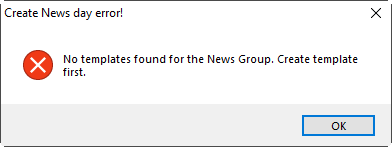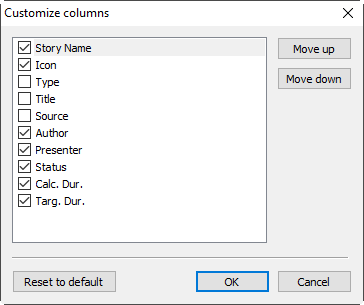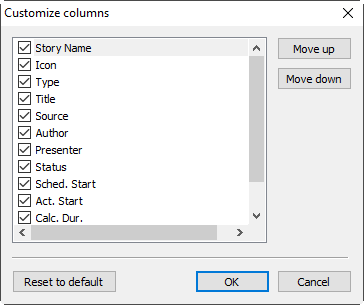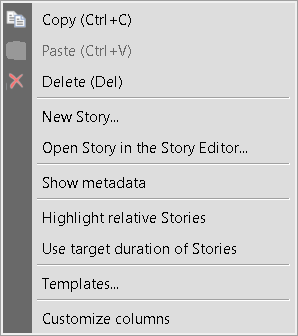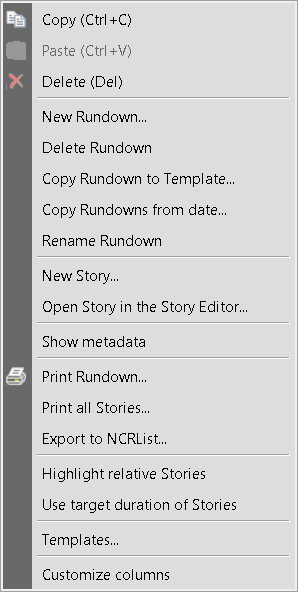News Program
Reading time ~10 minutes
Creating a News Program
To work with News Program Manager, it is necessary to create a News Program first. To do this, use the "New" > "New News Program" command from the folder context menu in the explorer window:
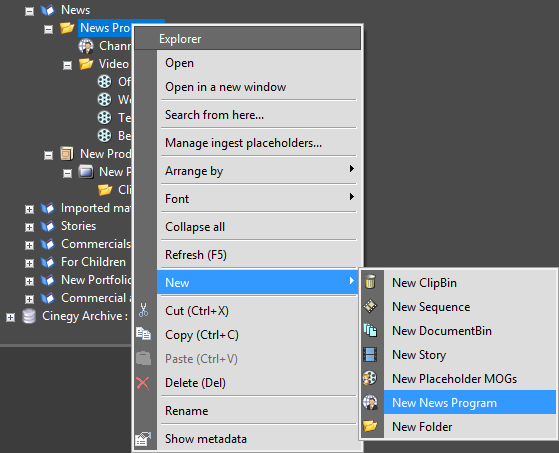
Define the name of the News Program and the Rundown TV format. Fill in the metadata fields if necessary and press the "OK" button to finish the process of the News Program creation.
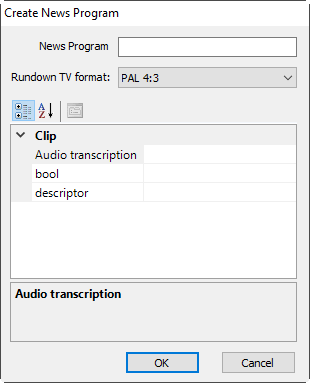
|
Important
|
The list of metadata fields is displayed if they have been assigned to the News Program node type. Please, refer to the Node Metadata article to learn more about node metadata. |
A News Program is the container for the Stories with video, audio and text material inside.
News Program Manager Interface
Double-clicking the News Program node will start News Program Manager:
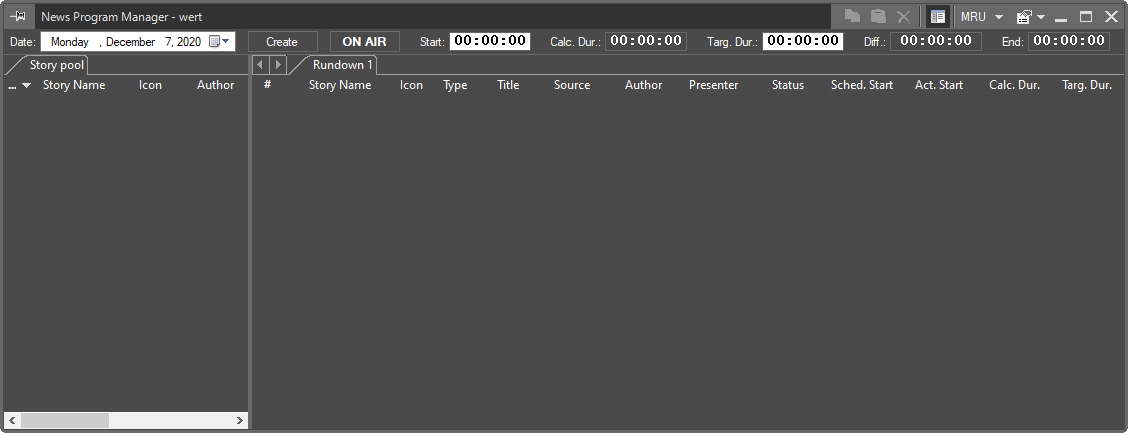
Select the date you want to compose a Rundown for:
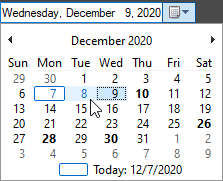
The coloring provides a convenient way of managing Rundowns for the needed dates:
|
The current date is shown in blue font with a blue frame. |
|
The date with the mouse pointer placed over is displayed in blue font and highlighted with a light-blue box. |
|
The selected date is displayed in a light-blue box. |
|
The bold font is used for all dates, for which Rundowns have already been created. |
|
To start composing a Rundown, press the "Create" button in the News Program Manager window. The new day will be activated and a set of Rundowns according to the specified template will be created. |
If no Rundown templates were previously created, you will be asked to create them first: |
|
|
|
Note
|
The "Create" button is disabled when previous dates are selected. It is possible to create a Rundown for a past date via the corresponding context menu command only if this date contains previously created Rundowns. |
|
Important
|
Refer to the Rundown Templates paragraph to learn how to create Rundown templates. |
The table view of the News Program Manager interface provides a convenient way to work with Stories:

The News Program Manager interface consists of two main parts:
-
Pool – the panel on the left, which is a storage for all the Story objects, usually used for work-in-progress material.
The pool displays the following Story parameters by default: Story name, icon displaying the status, author’s and presenter’s names, status, calculated and target durations. It is also possible to enable the display of the "Type", "Title" and "Source" columns.
-
Rundown – the panel on the right containing the sorted material to be sent to air.
NoteFor each date, you can assign multiple Rundowns in different TV formats. The Rundowns are represented as separate tabs and sorted by their start time. The rundown contains the same Story parameters as well as the time of planned and actual Story start. All of these columns are shown by default. The "Scheduled Start" column displays the planned start of each Story according to the calculation of values in the "Calculated Duration" column. When on-air mode is on, the "Actual Start" column displays the real start time for Stories being played back and for finished ones as well as the estimated start time for the rest of the Stories in the rundown. When on-air mode is disabled, the "Actual Start" column displays the real start time only for Stories that have been broadcast. For other Stories --:--:-- is displayed instead of the actual start value.
ImportantRefer to the On-Air Mode description within the Cinegy Studio Manual for more information about on-air mode.
Stories in the pool and rundown are numbered according to the order of their adding to News Program Manager. However, it is possible to sort Stories in the pool by double-clicking the desired column header. You can also rearrange the sorted Stories in reverse order by double-clicking on the column header again.
It is possible to customize the set and order of columns to be displayed for the pool and rundown by selecting the "Customize columns" command from the context menu of the pool and rundown correspondingly. The following dialogs will appear:
Pool |
Rundown |
|
|
Remove the selection of the columns you do not need to be displayed. It is also possible to define the order of the columns with the help of the "Move up" and "Move down" buttons. To restore the default settings, press the "Reset to default" button.
Main Panel

The main panel contains the following controls:
-
Date – the date for the News Program Manager schedule. You can edit the News Program Manager schedule for any date.
-
Start – the time of the Rundown start. You can define the start time of your show in this field.
-
Calculated Duration – the total calculated duration of the currently open Rundown.
-
Target Duration – the duration of the currently open Rundown. You can define the desired duration of your show in this field.
If the target duration does not match the calculated duration, the latter will be displayed in red as follows:

-
Difference – the difference between the target and calculated duration values of the currently open Rundown.
-
End – the calculated time of the Rundown end.
|
The "On Air" button enables/disables on-air mode. When on-air mode is enabled, the "On Air" sign is displayed in red. |
|
Note
|
Please note that pressing the "On Air" button in News Program Manager also enables/disables on-air mode in Cinegy Studio and vice versa. |
Color Coding and Status Icons
Depending on the status, Stories in the pool and rundown have color-coding and corresponding icons making it easier to work with them.
| Status | Icon | Description |
|---|---|---|
|
|
The "Status" column of the newly created Story is empty and a dash is displayed instead of the icon. |
|
|
The Story is being edited. |
|
|
The Story is marked with "Final approval". |
The following statuses, icons and color coding are displayed in the rundown only when on-air mode is enabled:
| Status | Icon | Description |
|---|---|---|
|
|
The Story, any item(s) of which is currently being played in Cinegy Studio. |
|
|
The Story, any item(s) of which is cued in Cinegy Studio and is not currently being played. |
|
|
The Story, any item(s) of which has already been played and is neither played nor cued in Cinegy Studio. |
When a Story has the "Locked" status, it is possible to see the user editing it by moving a mouse pointer to the "Status" column of this Story; a pop-up hint will appear indicating the user’s name:

Moving a mouse pointer to the "Status" column of the Story also allows you to view a pop-up hint with the name of the user having set the "Final approval" mark for the Story as well as the approval date and time:

The workflow steps are used until the Story gets final approval, that is why they are displayed in the "Status" column. They also have their own coloring to make the work with them more convenient. For example:
|
The "Blank" workflow step is used for the Story the work on which has not started yet |
|
The "In Progress" workflow step is used for work-in-progress Stories |
|
The "Pending" workflow step means that the Story is ready for final approval |
|
The "Declined" workflow step means that the Story is not approved or requires improvement |
|
The "Completed" workflow step means that the Story is ready to be broadcast |
|
Important
|
Refer to the News Options article in the Cinegy Archive Manager Manual to learn how to manage workflow steps. |
If the calculated duration of the prepared Story does not match the target duration (accurate to second), its value will be shown in red:

|
Note
|
Please note that the interface displays timecodes rounded to seconds. All the internal calculations are performed by the system including frames. |
If a Story is copied from the pool to the rundown or vice versa, such Stories become related. Stories copied from the pool to the rundown are highlighted in bold in the pool.
If related Stories are no longer identical due to changes made to one of them, the newer Story is highlighted in green and the older one is highlighted in pink. A Story is highlighted in yellow if it has several related Stories with different modification dates and their modification history is ambiguous.

|
Note
|
You can enable color indication of related Stories with changes using the "Highlight relative Stories" context menu option. |
Context Menu
The context menus for the pool and rundown are different. The following menus appear when you right-click the pool or rundown panel respectively:
Pool context menu: |
Rundown context menu: |
|
|
The following commands are available from the context menu:
-
Copy – copies the selected Story or Stories to the clipboard.
-
Paste – pastes the copied Story/Stories from the clipboard.
-
Delete – deletes the selected Story or Stories.
-
New Story… – creates a new Story in the pool or rundown correspondingly.
ImportantThe Story can also be added via drag-and-drop of a Sequence, clip or Cinegy Titler template to the pool or rundown area. A new Story will be automatically created and opened in Story Editor, containing the dragged-and-dropped item on track Video 1 or Graphics 1 respectively. Please refer to the Working with Stories section for detailed description of Story Editor. A quick way to add the Story is dragging the existing news item into the News Program Manager either to the pool or rundown area. The newly created Story will be opened in the Story Editor and become active. The Story Data fields including name, title, synopsis and source will be populated automatically. The Transcript block will contain the text of the Story:
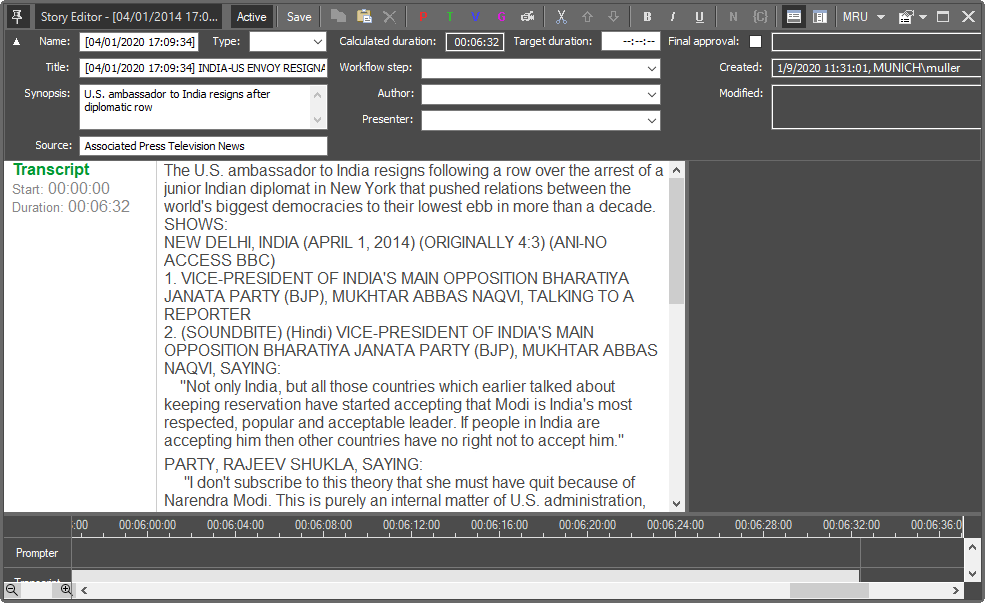
-
Open Story in the Story Editor… – opens the selected Story in Story Editor for viewing or editing.
ImportantRefer to the Working with Stories section to learn how to work with Story Editor. -
Show metadata – displays metadata of the selected Story.
-
Highlight relative Stories – enables indication of the changes made in related Stories.
TipWhen enabled, related Stories in both the pool and rundown are automatically selected when the user selects any of them.
-
Use target duration of Stories - calculates the target duration for the Rundown.
TipIf the Story target duration is not configured, the Rundown target duration field shows the total target durations of all Stories and Rundown target duration cannot be edited - it is calculated automatically, giving priority to Story target duration. If the Story target duration is configured, the Story timing for calculating start time of the next Story is based on "Target duration", but not on the "Calc. Duration" value. -
Print Rundown… – prints the content of the Rundown. The "Print Setup" dialog box will appear allowing you to define the common print settings.
ImportantRefer to the Printing Rundown paragraph to learn how to print the Rundown. -
Print all Stories… – prints the content of all the Stories included in the Rundown. The "Print Setup" dialog box will appear allowing you to define the print settings.
ImportantRefer to the Printing All Stories paragraph to learn how to print all Stories. -
Export to NCRList… – saves the current Rundown as a playlist in the NCRList format in the defined location.
-
New Rundown… – creates a new Rundown.
-
Delete Rundown – deletes the current Rundown.
-
Copy Rundown to Template – copies the current Rundown with its content to the selected template.
-
Copy Rundowns from date – copies all the Rundowns with their content from the selected date to the current day.
-
Rename Rundown – allows changing the current name of the Rundown via the following dialog box:
 Note
NoteCommands for interacting with Rundown are available only from the rundown context menu. -
Templates… – opens the "Templates" dialog box for templates creation and management.
ImportantRefer to the Rundown Templates paragraph to learn how to create and manage templates. -
Customize columns – customize the set and order of columns to be displayed for the pool and rundown.





